Recently, a series of flight tests demonstrated the first Smart Node Pod produced for the U.S. Air Force. The Smart Node Pod is an aircraft-mounted airborne communications system. By helping to build out a multi-tiered joint-aerial-layer-network (JALN) architecture, it provides network connectivity across the battlespace. In the demonstration, for example, the Smart Node Pod successfully transmitted full-motion video, imagery, and voice and digital messages between warfighters in the air and on the ground.
The Smart Node Pod promises to extend support for line-of-sight and beyond-line-of-sight, tactical-data-link (TDL), and IP-based communications in the JALN. Based on Northrop Grumman’s Battlefield Airborne Communications Node (BACN) platform, the Smart Node Pod is available in both single- and multi-pod architectures. It utilizes various waveforms and datalinks. In addition, the pod is compatible with a variety of radios, making it interoperable with BACN platforms to create a complete multi-layer airborne network.
The communications payload bridges data and voice communications, projecting those network capabilities to the edge of the battlefield. This feature gives military personnel the necessary flexibility to extend traditional tactical and strategic communications for various intelligence, surveillance, and reconnaissance (ISR) missions. Northrop Grumman is under contract to produce the Smart Node Pod systems with deliveries expected through mid-summer.
